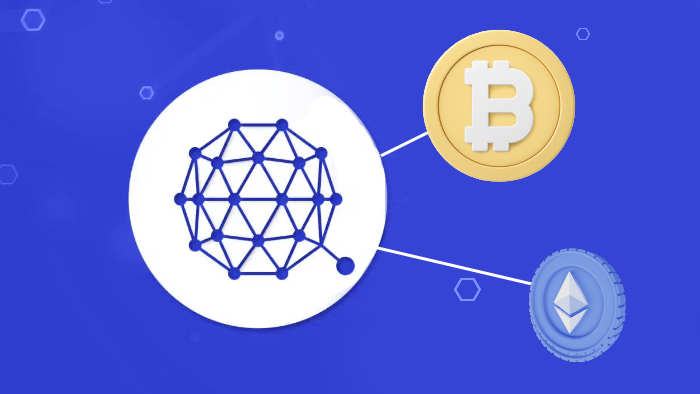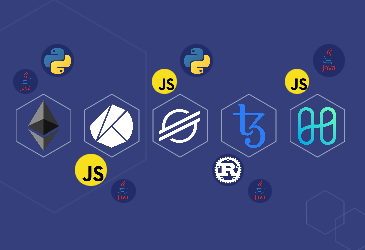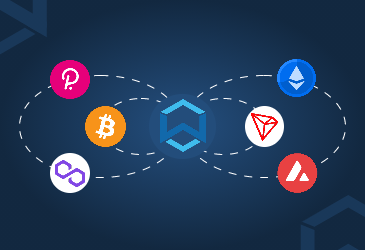
Qtum- Producing the best From Ethereum and Bitcoin
Blockchain technology has come a long way since the birth of Bitcoin. New layer1 platforms employ innovations that go far beyond the Bitcoin model. Qtum blockchain combines the smart contract functionality of Ethereum with the security and anonymity of Bitcoin’s transaction output model (UTXO). As per reports, the Qtum native coin QTUM was ranked #98 in terms of overall market capitalization as of August 2022. Its price hovered around $3.48 and had a market cap of $363.15 millions. It relies on a proof of stake consensus model to create new blocks, which is much easier than Bitcoin’s proof of work model.
Qtum was designed for use by large organizations intending to integrate it into various industries, including finance and social media. Qtum has taken elements from both Ethereum and Bitcoin, combining the security of Bitcoin’s blockchain model and the flexibility of Ethereum’s smart contracts. Because of its unique architecture, this combination makes Qtum a very interesting project. If you have ever wondered what makes Qtum special, this insight is for you. Through this insight, we will walk you through the unique aspects of Qtum.
What is Qtum?
Qtum, pronounced as Quantum, is a fast, green, stable, decentralized and proof-of-stake-based blockchain platform that is scalable and that allows developers to harness the benefits of Bitcoin and Ethereum. It is more decentralized than most blockchains, which makes it more censorship-resistant. Qtum hopes it will disrupt the online transaction market and be integral to the finance and social networking industries. Qtum uses Bitcoin core to build its network for security and stability purposes. Qtum operates using a UTXO model. The project integrated Ethereum’s virtual machines (EVM) so that the chain could run Turning full code required to support smart contracts and decentralized applications (dApps). Qtum’s stack includes a middleware layer and an account abstraction layer (AAL), ensuring that the UTXO set is compatible with smart contract execution layers. Qtum’s native token, QTUM, allows users to pay transaction fees and participate in network security. Users can also vote on protocol upgrades.
Features of Qtum
- Decentralized governance – Qtum is unique in its ability to modify parameters in a distributed fashion. The community has access to a number of smart contracts that allow them to adjust parameters like gas prices, block sizes, and other important features.
- Speed – Qtum could theoretically perform “millions to billions” of transactions per second if it combines various layer-1 and layer-2 solutions. It’s current layer1 network has a capacity of around 1100 tps.
- Proof of stake- Qtum uses the energy-efficient and scalable proof-of-stake method to protect its network. To stake, participants can use low-powered devices or do it offline to save more energy.
- Upstream support- Being an independent blockchain, Qtum combines the best of Ethereum and Bitcoin. It can receive game-changing updates from both Ethereum and Bitcoin ecosystems.
- Token standards- Qtum makes it easy to access industry standards like NFT functionality and ERC20 tokens. You don’t need to pay high gas fees to send and receive various tokens, both fungible and non-fungible.
- Janas – This is a web3 adapter that can be used to interact with Qtum as a proxy adapter and web3 provider. It makes it easy for developers to port solidity-based applications into Qtum.
History
Qtum was founded by Patrick Dai, Neil Mahi and Jordan Earls in 2016, and its Initial coin offering (ICO) was held in March 2017. The Qtum Blockchain seeks to combine the best features of the Ethereum and Bitcoin blockchains to create an intelligent contracting platform. It uses the Bitcoin core code as its foundation for security and stability reasons. Qtum integrated Ethereum’s virtual machine into Bitcoin, allowing the network to run decentralized applications (dApps). It plans to add additional virtual machines to the network, including the X86 VM to support smart contract programming languages other than Solidity.
Combining Ethereum and Bitcoin attributes can cause compatibility issues. To track coin ownership, Bitcoin uses the UTXO system. Ethereum, like most protocols with virtual machines, uses an account-based model. Qtum’s tech stack contains a layer called the account abstraction layer (AAL) that converts Bitcoin code to the EVM. This ensures virtual machine compatibility and UTXO.
Qtum chose to use a modified proof-of-stake (PoS) model from Blackcoin as its consensus mechanism. According to the Qtum team, proof-of-work blockchain protocols suffer from categorial scaling limits that PoS could alleviate. Qtum has an on-chain governance protocol (also known as Decentralized Governance Protocol or DGP) which allows token holders to take over decision-making. Block size and base gas fees are two network parameters for consideration. The Qtum Foundation is a key player in developing and promoting the Qtum blockchain.
Technology
The Qtum blockchain implements the first iteration of a proof-of-stake consensus mechanism, incentive proof-of-stake (IPoS), that is compatible with UTXO-based blockchains such as Bitcoin. Qtum’s UTXO model was selected to allow for consistent, traceable transactions on-chain. The IPoS model builds on existing PoS models and introduces reward mechanisms based on online node number estimates. Qtum will initially launch with a proof-of-stake (PoS) model but plans to move to the IPoS model during later stages.
Qtum consumers and developers rely on the Ethereum Virtual Machine, just like the Ethereum blockchain. The Qtum EVM, however, is different in that it is always backward compatible with Ethereum’s EVM. Also, it supports an Account Abstraction layer (AAL), which allows the EVM to run existing Ethereum smart contracts on Qtum with minimal modifications. Qtum’s Contract Ledger stores smart contract language, data feeds and oracles to execute contracts.
Qtum must prioritize transaction confirmation in order to be able to concentrate on two distinct qualities as a type of Bitcoin-Ethereum hybrid blockchain. The transaction size should be equal to the fee, which is similar to a standard proof-of-work (PoW), and on-chain transaction fee. Also, the gas fee should match available and expected funds.
What is UTXO?
UTXO stands for Unspent Transaction Outputs. They are a common concept in cryptocurrency. In some networks, cryptocurrency transactions can be made from inputs and outputs. For example, to send 1 BTC, you will need to input UTXOs in order to “send” it as an output. These UTXOs become a new UTXO when marked as “spent.”
Imagine that you are sending 0.6 BTC. It can comprise 0.4 BTC and 0.2 BTC output transactions. If you want to send only 0.3 BTC, you will need to split the 0.4 BTC UTXO into 0.3 BTC for your friend and 0.1 for yourself. This leaves two new UTXOs of 0.3 BTC and 0.1 BTC.
Although it may seem strange, this system of accounting has its advantages:
- Double spending is easy to avoid, as you can easily see if an output has already been spent.
- A network can process transactions in parallel, as each transaction has its own outputs.
Ethereum uses a transaction model that is similar to a bank account, and this model keeps a global record of all balances across the network.
What is Account Abstraction Layer?
For technical reasons, a blockchain with smart contract capability doesn’t usually use the UTXO account software, and Qtum suggests using an Account Abstraction Layer. The name implies that Ethereum’s accounts system can be abstracted from its technical implementation.
Smart contracts can be used with an accounts model. This allows them to work with an address or the smart contract’s balance. UTXO is a different type of smart contract. A smart contract must choose which UTXOs it will use, often from multiple addresses. Inter-contract transactions also pose a problem. The UTXO blockchain must keep track of all transactions.
AAL creates a smart contract by using the output of a UTXO transaction. The transaction is then sent to the contract account for execution. AAL processes these results and adjusts them to UTXO. Qtum can take advantage of Bitcoin and Ethereum updates through the AAL technology. It could quickly adopt non-fungible token support that was added to Ethereum. Qtum can benefit from the Lightning Network, and other technologies by being UTXO-based.
What is proof of stake?
Qtum’s unique consensus mechanism is Mutualized Proof of Stake. It was designed by the Qtum team to reduce junk contract spam attacks and increase their cost. This mechanism splits block rewards among block-producing nodes and delays payment. Each reward is divided equally between the successful validator as well as the nine previous successful validators, and 500 blocks are added to delay a portion of the reward. This makes it difficult for attackers to calculate exact rewards from an attack.
How does Qtum work?
The Qtum network has four important aspects:
- Accounting using the UTXO model
- Solidity smart contract platform
- An Account Abstraction Layer
- A Proof of Stake consensus mechanism
Qtum uses Bitcoin’s UTXO transaction method, which is the acronym for unspent transaction outputs. This refers to the amount of cryptocurrency left unspent after the transaction, similar to the change leftover after a traditional cash transaction. UTXOs can be processed continuously and kept on the ledger. To unlock them, you will need a private key.
Through the x86 virtual machine, smart contract functionality is also made available. Qtum’s x86 virtual machine supports many programming languages, including Python, C++ and C. This help to accelerate the mainstream adoption of smart contract technology.
Bitcoin’s transaction model and Ethereum compatibility are achieved through the Account Abstraction Layer, which decouples applications from the underlying protocol. AAL abstracts individual UTXO transactions to create a single balance that allows for the smooth operation of smart contracts using the Ethereum virtual machine. It is possible to expand smart contract capabilities in the future. Qtum’s Decentralized Governance Protocol allows smart contracts to alter specific blockchain settings. DGP, for example, allows the community to modify block size or base gas fee without the need to fork.
Governance
Qtum has an on-chain governance system that manages specific network parameters. However, it also offers an off-chain process to approve and carry out larger protocol changes. This type of upgrade, which includes adding new features such as a VM to the network, requires a network fork. The Qtum Chain Foundation plays an important role in developing and directing the Qtum blockchain. It oversees the creation and implementation of new network features and helps manage the Qtum Code Base.
Qtum implemented an on-chain governance protocol called the Decentralized Governance Protocol (DGP) to allow for changes to network parameters. DGP covers block size and the base cost of gas fees. Participants are responsible for approving the adjustments, and they can use their QTUM tokens to support or reject a proposal. The DGP will be able to issue soft forks with approving changes (if possible), which will prevent network disruptions often caused by hard fork upgrades. For more significant upgrades, which would require a hard fork to be implemented, Qtum’s off-chain governance process would be used.
The DGP process consists of four steps:
- A proposal is created by a network participant or group of stakeholders seeking to alter a particular network parameter.
- Each governance participant votes on the proposal.
- Accepted changes will be implemented automatically by the network. Rejection will not affect the network’s ability to continue functioning as it is now.
- The archived data includes all proposal data.
Why is Qtum unique?
Qtum has created the first proof of stake blockchain to use the UTXO transaction method with additional smart contract functionality. This project combines the security of Bitcoin and the functionality of Ethereum using a more efficient proof of stake consensus method. This pragmatic design approach is possible because of the unique use of the Decentralized Governance Protocol and Account Abstraction Layer technologies, and it provides a performance advantage over other blockchains.
Qtum found the Bitcoin blockchain inadequate in determining miners’ fees. The project adopts the Ethereum gas model, which allows for the reimbursement of gas that has been used. Qtum does not expect the gas price to be identical to Ethereum and instead creates a free-market fee model that allows both miners as well as users to optimize their operations.
What gives Qtum value?
Because of its unique combination of security, functionality and efficiency, the Qtum blockchain provides a valuable environment to developers. The platform’s compatibility with both Bitcoin and Ethereum, as well as developer resources and a range of supported programming languages, make it suitable for various applications.
QTUM cryptocurrency, on the other hand, derives its value from its utility. Developers are interested in the Qtum cryptocurrency because it is necessary to pay smart contract execution and QRC-20 transaction fees. Qtum is an integral part of the proof of stake consensus system, which allows token owners to gain more value by staking. The QTUM holders have the right to vote on network upgrades and participate in protocol governance, and their voting power is proportional to the QTUM staked.
How to use Qtum?
Qtum’s Ethereum compatibility allows Ethereum dApps to be easily deployed to the network. Mainstream developers can also use the technology stack because it supports various programming languages. Blockchain is intended for businesses, and its interoperability makes it ideal for supporting functions such as logistics, production, planning, and other partner systems.
QTUM tokens can be used to transfer value and staking and pay fees for smart contract execution of QRC-20 transactions. The QTUM holders are eligible to participate in protocol governance.
Conclusion
The Qtum blockchain offers a unique solution. It solves the issues associated with proof-of-work (PoW) and implements a PoS system that allows for upgrades. It supports smart contracts, decentralized applications(dApps), and UTXO accounting. Qtum is a successful example of how to leverage useful functionalities of existing blockchain platforms in a new one. If you have been considering Qtum, you can now make an informed decision based on its use cases.
If you want to learn about the performance of the Qtum network, the foundation tools it provides, and more, you can check out Scortik for Qtum Review and Rating.
Insights

What are SDKs? Top blockchains and their SDKs
A software development kit or SDK is a set of tools and programs utilized to build and integrate customized applications for any existing or new platform.

How to Choose a Blockchain Protocol Suitable to Your Project?
Need help choosing the right blockchain protocol for your project? Use Scortik to evaluate protocols’ overall performance and make the right choice.

WanChain: Empowering Blockchains With Interoperability
Wanchain is a blockchain interoperability and decentralized finance platform that connects multiple blockchains with one another.